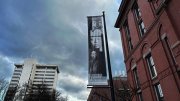The Peabody Museum of Archaeology and Ethnology has begun removing Native American funerary objects from its exhibits, after federal regulations went into effect earlier this month barring museums from displaying the sacred cultural items without consulting with and obtaining consent from tribes.
On Monday, a Peabody spokesperson did not say how many objects will be removed, but a note on the museum’s website lists closures for maintenance scheduled for January and February in nine galleries, including those related to indigenous peoples in the Northeast, Great Plains, and the Pacific Northwest. A statement this week from the museum said that its staff was in the process of removing “all funerary belongings and likely funerary belongings” from display.
The new regulations pertain to the Native American Graves Protection and Repatriation Act (NAGPRA) passed in 1990, which requires institutions to repatriate human remains and funerary objects and other items to the tribes from which they were taken. The law originally gave institutions five years to catalog their collections and return the objects. But 34 years later, Harvard and numerous other institutions still possess thousands of remains and sacred objects (Harvard has one of the largest such holdings in the country). University leaders have been sharply criticized for the delay, including at a conference last November that brought indigenous leaders to campus. The new rule allows institutions until 2029 to update their inventories of remains and funerary objects and to consult with tribes about them.
According to the Peabody’s statement on the decision to remove funerary objects from display, “The Museum has collaborated with Tribal Nations on new exhibitions for many years, including the ongoing exhibits The Legacy of Penobscot Canoes in collaboration with the Penobscot Nation and Wiyohpiayata: Lakota Images of the Contested West co-curated with Lakota artist Butch Thunder Hawk. The Museum has not exhibited ancestral remains for more than 20 years. Exhibitions have always been discussed during Tribal consultations and cultural items have been removed from display at Tribal request.”
The University first apologized for the Peabody’s holdings of indigenous remains in 2021. After the museum discovered the remains of 15 possibly enslaved people in its collection, then-President Lawrence Bacow, in a letter to the Harvard community that also noted the museum’s Native American remains, apologized for “collection practices that placed the academic enterprise above respect for the dead and human decency.” And in a simultaneous message to the Peabody community, Seabury Howells director Jane Pickering acknowledged that the museum was “intricately linked to19th century legacies of settler colonialism and imperialism.” She pledged to “prioritize the urgent work of understanding illuminating our history and to begin to make amends.”
Since then, the Peabody has increased its repatriation efforts. According to a Harvard Gazette update from late October, the University had at that time returned the remains of a cumulative total of 4,347 individuals (out of the more than 10,000 human remains originally reported to the federal government), and a total of 10,016 funerary objects (out of more than 18,500). This month, the University announced that it would provide travel funding for tribal representatives to come to the Peabody Museum and physically take possession of items.
A number of other institutions are also now removing funerary objects in response to the updated NAGPRA regulations, including the American Museum of Natural History in New York City and the Field Museum in Chicago. In addition to requiring consultation and approval from tribes before displaying those sacred objects, the new NAGPRA rule lays out several other changes. Among them is a requirement that institutions defer “to the indigenous knowledge of lineal descendants, tribes and Native Hawaiian organizations” in the repatriation process. Another change eliminates the category of “culturally unidentifiable human remains” and renews the requirements for cultural affiliation to “better align” with the original law’s intent. Thousands of the remains in Harvard’s holdings have been deemed culturally unidentifiable; in a 2021 letter to the University, the Association on American Indian Affairs argued that for the vast majority of those “unidentifiable” remains, enough information is available to identify and repatriate them.









